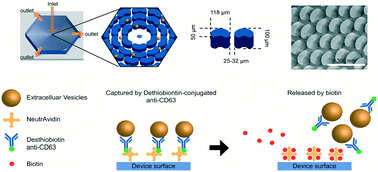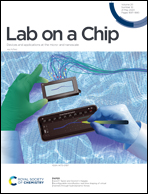Microfluidic device for high-throughput affinity-based isolation of extracellular vesicles†
Abstract
Immunoaffinity based EV isolation technologies use antibodies targeting surface markers on EVs to provide higher isolation specificity and purity compared to existing approaches. One standing challenge for researchers is how to release captured EVs from the substrate to increase downstream and biological studies. The strong binding between the antibody and antigen or the antibody and substrate is commonly unbreakable without operating at conditions outside of the critical physiological range, making the release of EVs problematic. Additionally, immuno-affinity approaches are usually low-throughput due to their low flow velocity to ensure adequate time for antibody–antigen binding. To overcome these limitations, we modified the OncoBean chip, a previously reported circulating tumor cell isolation microfluidic device. The OncoBean chip is a radial flow microfluidic device with bean-shape microposts functionalized with biotin-conjugated EPCAM antibody through biotin–avidin link chemistry. It was demonstrated that the high surface area and varying shear rate provided by the bean-shaped posts and the radial flow design in the chip, enabled efficient capture of CTCs at high flow rate. We replace the anti-EPCAM with antibodies that recognize common EV surface markers to achieve high-throughput EV isolation. Moreover, by incorporating desthiobiotin-conjugated antibodies, EVs can be released from the device after capture, which offers a significant improvement over the existing isolation. The released EVs were found to be functional by confirming their uptake by cells using flow cytometry and fluorescent microscopy. We believe the proposed technology can facilitate both the study of EVs as cell-to-cell communicators and the further identification of EV markers.



 Please wait while we load your content...
Please wait while we load your content...
